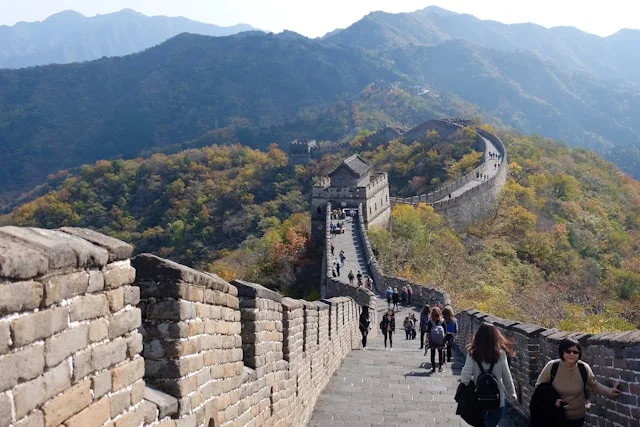The Majestic Great Wall of China
1. Historical Significance
The Great Wall of China, stretching over 13,000 miles, is a testament to the ingenuity and perseverance of ancient Chinese civilizations. Originally built to protect against invasions, it stands as one of the most remarkable architectural feats in human history. The wall traverses diverse terrains, from deserts and mountains to plateaus, showcasing the country’s geographical diversity.
2. Key Sections to Visit
- Badaling: The most popular and well-preserved section, known for its accessibility and historical importance. Here, visitors can explore watchtowers and parapets while enjoying panoramic views of the surrounding mountains.
- Mutianyu: Famous for its restored sections and fewer crowds, Mutianyu offers a more relaxed experience with its lush greenery and stunning views. It is also equipped with a cable car for easier access.
- Jiankou: Known for its wild and rugged terrain, Jiankou is a favorite among hikers and photographers. This section remains unrestored, providing a more authentic and adventurous experience.
Zhangjiajie: The Avatar Mountains
1. The Enchanting Landscape
Zhangjiajie, located in Hunan Province, is renowned for its towering sandstone pillars and ethereal beauty. These unique formations inspired the floating mountains in the movie “Avatar.” The Zhangjiajie National Forest Park, part of the larger Wulingyuan Scenic Area, is a UNESCO World Heritage Site and a haven for nature enthusiasts.
2. Top Attractions
- Tianmen Mountain: Known as the “Heaven’s Gate,” Tianmen Mountain is famous for its natural arch, the Tianmen Cave. The mountain also boasts the world’s longest cable car ride and a thrilling glass skywalk that offers breathtaking views of the surrounding landscape.
- Huangshi Village: This area provides some of the best views of the sandstone pillars. Visitors can hike to various viewpoints or take a cable car to experience the scenery from above.
- Avatar Hallelujah Mountain: Originally named “Southern Sky Column,” this pillar was renamed after the film “Avatar.” It is one of the most photographed spots in the park, offering a surreal and otherworldly experience.
The Karst Landscapes of Guilin and Yangshuo
1. Picturesque Scenery
Guilin and Yangshuo, located in Guangxi Province, are famous for their karst landscapes, characterized by limestone peaks and crystal-clear rivers. The Li River, which flows between these two towns, is celebrated for its stunning scenery and has inspired countless Chinese paintings and poems.
2. Must-See Spots
- Li River Cruise: A cruise along the Li River is a must-do activity, offering breathtaking views of the karst mountains, bamboo groves, and picturesque villages. The section between Guilin and Yangshuo is particularly famous.
- Reed Flute Cave: Known as the “Palace of Natural Arts,” this cave features stunning limestone formations illuminated by multicolored lights. The cave also contains inscriptions dating back to the Tang Dynasty.
- Moon Hill: A natural arch with a large, moon-shaped hole at its peak, Moon Hill offers panoramic views of the surrounding countryside. It is a popular spot for hiking and photography.
The Serene Beauty of Jiuzhaigou Valley
1. A Fairyland of Colors

Jiuzhaigou Valley, located in Sichuan Province, is a UNESCO World Heritage Site known for its multicolored lakes, waterfalls, and snow-capped peaks. The valley is home to diverse ecosystems and offers a serene escape into nature.
2. Highlights of Jiuzhaigou
- Five Flower Lake: Known for its crystal-clear waters that reflect different colors, this lake is one of the most beautiful spots in Jiuzhaigou. The lake’s vibrant hues are due to its mineral deposits and aquatic plants.
- Nuorilang Waterfall: One of the widest waterfalls in China, Nuorilang is a stunning sight, especially when it is illuminated by the morning sun. The waterfall is particularly spectacular in autumn when the surrounding foliage turns vibrant shades of red and gold.
- Zechawa Valley: This area is home to some of the highest lakes in Jiuzhaigou, including Long Lake and Five-Color Pond. The valley offers breathtaking views of the surrounding mountains and is ideal for hiking.
The Vast Deserts of Dunhuang
1. Echoing-Sand Mountain and Crescent Lake
Dunhuang, located on the edge of the Gobi Desert, is famous for its vast sand dunes and the enchanting Crescent Lake. The Echoing-Sand Mountain gets its name from the sound the sand makes when it shifts in the wind, while the Crescent Lake, an oasis in the desert, has been a vital water source for centuries.
2. Mogao Caves
Also known as the Thousand Buddha Grottoes, the Mogao Caves are a significant cultural and historical site. These caves house some of the finest examples of Buddhist art spanning over a millennium, with intricate murals and statues.
The Tibetan Plateau: Roof of the World
1. Lhasa and Potala Palace
The Tibetan Plateau, often referred to as the “Roof of the World,” is home to some of China’s most significant cultural and natural sites. Lhasa, the capital of Tibet, is renowned for the Potala Palace, a UNESCO World Heritage Site and a symbol of Tibetan Buddhism.
2. Yamdrok Lake
One of Tibet’s three sacred lakes, Yamdrok Lake, is known for its stunning turquoise waters and the surrounding snow-capped mountains. The lake is a spiritual site for Tibetan pilgrims and offers breathtaking views for visitors.


